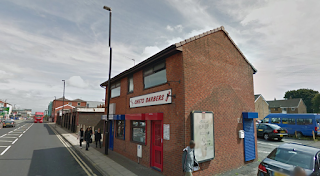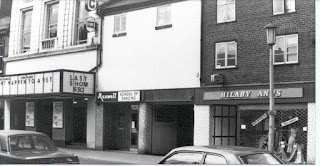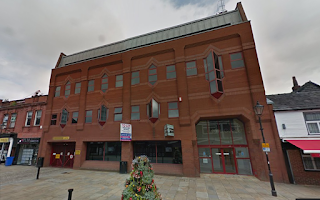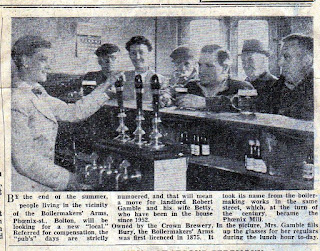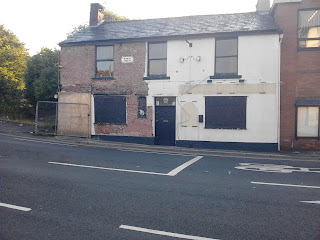The
Alexandra was situated on the corner of Mount Street and Stewart
Street quite close to what is now Brownlow Way.
The
first record of the pub comes in 1868 when John Halliwell is listed
as a beerseller at 14 Mount Street. However, an application to the
local magistrates for a spirit licence in 1878 claimed that the pub
was built 13 years earlier in 1865 . [1]
In
his book Bolton Pubs 1800-2000, Gordon Readyhough tells us that
Halliwell began his brewing business in 1856. Prior to that he had
lived in Sharples where he worked as a bleacher. It is possible that
he opened the pub that became Alexandra at the same time he began the
brewing business as that part of Halliwell was in the process of
being built up around that time. The name Alexandra comes from
Princess Alexandra of Denmark who married Queen Victoria’s eldest
son, the Prince of Wales in 1863. That also gives us a possible date
for the pub. She became Queen Alexandra when her husband King Edward
VII acceded to the throne on Victoria’s death in 1901.
By
1871, the address of the Alexandra pub is given at 14 Stewart Street.
John Halliwell is there. He is 39-years-old and his occupation is
given as a brewer. His wife Martha is 41 and there are six children
including Edward, 16, who worked for his father as a brewer, and
John, aged 10. By this stage Halliwell had built a brewery next to
the pub.
The
business expanded and by 1876 John had left the pub and was living at
77 Chorley Old Road. Edward Buckley had taken over as licensee of the
Alexandra and in 1881 he applied again for a spirit licence. Up to
then the pub had sold only beer. The application was refused along
with similar applications for the Rock House Hotel and for Mere Hall,
then owned by Richard Haworth. Mr Haworth said in his particular
application that he had purchased Mere Hall ten years previously and
had laid out the grounds surrounding the mansion. He had also built
317 houses in the vicinity. No matter, one of the occupants of those
317 homes complained, as did a Mr Bradbury who got up a petition to
object to the granting of the licence. Like the Alexandra and the
Rock,
the Mere Hall didn’t get its spirit licence.
John
Halliwell’s wife, Martha (nee Whittaker) died in 1879. The couple
had married at St Paul’s in Astley Bridge in 1853. John remarried
the following year this time to Jane Fielding, a provision dealer
from Blackburn Road. However, he died in 1885 and the business was
taken over by his eldest son, Edward.
It
was under Edward Halliwell that the business grew. In 1881 he was
living at 85 Hampden Street, just a few yards away from the brewery.
But his influence within the business was already such that he was
described on the census form for that year as a master brewer
employing 11 men. He was 26 at the time and living with his
22-year-old wife Ann and their one-year-old daughter Florence. But in
1890 Edward made the decision to sell the brewery, its 12 pubs –
including the Alexandra – and nine off-licences. [2]
By
1891 the family were living in much more salubrious surroundings at
108 Chorley New Road, a large semi-detached house which still stands
opposite Bolton School. Edward Halliwell took a back seat in the
running of the brewery and by 1901 he was living on Westcliffe Road,
Birkdale, near Southport along with his wife and daughter. The family
had been hit by tragedy with the death of Edward’s brother, John
Halliwell, in 1891. John had worked for the brewery as a salesman and
could claim some credit for the business’s growth. He was just 30
years old when he died.
Edward
also died at a relatively young age. He was 49 when he died while on
a visit to Merionethshire in Wales. He left an estate valued an
estate valued at £16584 – the equivalent of £1.8million today –
split between his wife, his daughter and his brother, James
Halliwell, who had eschewed a life in the brewing industry to become
a vet.
Back
at the Alexandra, George Hamilton took over in 1885. A former joiner
from nearby Brougham Street he was at the pub for well over 25 years.
George was at the Alexandra when it changed ownership. In December
1910, another local brewer, Magee, Marshall and Co, made an offer to
buy Halliwell's brewery and its small tied estate of pubs, including
the Alexandra. After the deal went through the brewery closed and it
was demolished in the 1920s. For many years its site was a wasteland
colloquially known to local children as ‘the brewery’.
The Alexandra carried on into the
1930s. It gained a full licence in the early part of 1935 when the
wine and spirits licence of the Four Factories on Turton Street was
transferred.
It lasted until the 1960s when it closed and was demolished as part
of the clearance of that part of the Halliwell area.
Stewart
Street can be seen in the distance on the other side of this car park
off Back Grantham Close. But the building in the foreground is
actually the site of the Alexandra Hotel.
[1]
Bolton Evening News, 28 August 1878,
[2]
Bolton Evening News, 3 December 1890.
For
the record the other pubs were:
Blue
Bell Inn on Kay Street,
Royal
Oak, 115-117 Kay Street;
JunctionInn on the corner of Egyptian Street and St John Street;
Victoria
British Queen, 124-126 Blackburn Road,
LordAshley
on Tyndall Street, which was sold along with five adjoining houses
which the brewery also owned;
SeftonArms on the corner of Thwaites Street and Brougham Street;
Church
Inn, Manchester Road, Little Hulton.
The
off-licences were situated at:
515-517
Halliwell Road,
138
Halliwell Road,
1-3
John Brown Street,
1-5
Hill Lane, off Windley Street,
10-12
Back Turton Street,
41-43
George Street, Astley Bridge,
36-38
Balshaw Street,
58-60
Morris Green Lane.
Stewart Street can be seen in the
distance on the other side of this car park off Back Grantham Close. But the
building in the foreground is actually the site of the Alexandra Hotel.
Edited 12 November 2018 to include details of the pub's inclusion in the sale of Halliwell's brewery in 1890.



